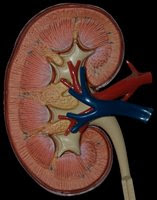The Dimensions of Dialysis
by Stephen Z. Fadem, M.D., FASN
A Response to God Help You, You're on Dialysis
Atlantic Magazine, December 2010
God Help You, You’re on Dialysis is an investigative journalism article that appeared in the December 2010, Atlantic Magazine. It tries to explicitly highlight everything that is wrong with dialysis. This dismal picture, however, is strictly one-dimensional.
Dialysis has emerged and progressed since 1972 as a life-saving gift to people who earlier would have died. In 1969, while in medical school, I saw a four-year-old African American child die with uremia because he did not qualify for dialysis. Through the years since then we have honed our skills and greatly expanded the dialysis program. In many countries, there is no government financial support of dialysis therapy, and as a result those patients who cannot afford care succumb to their illness. We now dialyze an older set of patients and have less hospital time. We are identifying outcome measures that simply do not work, and creating plans to identify and strongly support those that do. We are looking at what is best about dialysis in other countries and incorporating that into our efforts to care for patients. At the same time, we are now more focused on the quality of life and on educating patients well before they ever require dialysis. In this fashion many patients can select to preemptively undergo a kidney transplant or choose a home dialysis modality. Other patients with concurrent morbid conditions may elect not to choose dialysis at all. All of this progress is made despite wanton cuts in funding and critical nurse shortages. Sadly, many patients who enter a dialysis program missed an opportunity earlier in their lives to control their lifestyles and eating habits. The results of uncontrolled obesity, cardiovascular disease, diabetes or hypertension are comingled with inexorably progressive kidney failure.
Like the muckrackers of the early 1900s, whose model was to selectively report the sensational negative aspects within an industry, the author of this paper only looks in one direction. The name muckracker was attributed to Theodore Roosevelt. It is memorialized in a speech that is just as timely today as it was 100 years ago.
“... you may recall the description of the Man with the Muck-rake, the man who could look no way but downward with the muck-rake in his hands; Who was offered a celestial crown for his muck-rake, but who would neither look up nor regard the crown he was offered, but continued to rake to himself the filth of the floor.”
The facts are there; there are problems within the dialysis profession. Many patients come to dialysis poorly prepared, having been poorly educated as to what to expect. Alternate therapies have not been explained to them; they do not have an appropriate access placed, and are unaware of their responsibilities toward their care.
The have been cuts in the program; it is an entitlement and thus engenders a negative reaction among those who are trying to create a fiscally responsible government. Worse, the fear of what will happen next, as new cost containment initiatives are rolled out, has been very unsettling.
In dealing with very human issues, mistakes happen. Unfortunately catastrophes occur in a small minority of instances. Our profession at large is very aware that the potential for an accident or an infection is high by the nature of what we do, and we strive hard to meet our task with an abundance of caution. Most instances are “near misses” and lead to quality improvement processes that improve the system. Ineptitude is strongly addressed internally through counseling, retraining and sometimes employee termination. Some instances of negligence lead to unexpected outcomes, and are dealt with in the court system, and sometimes through state or federal sanctions.
Dialysis facility inspections are performed less frequently because of the lack of well-trained surveyors at the state or federal level. However, internal surveys are regularly performed. A survey at any level is very helpful to a dialysis center – we welcome it an important tool in pointing out deficiencies and weaknesses. It serves to enable the team to receive extra help and advice from outside experts. In the majority of instances there is a period of corrective action followed by another survey. During this time the facility retrains its employees and works through process to develop a stronger infrastructure. Many of these facilities go on to become model units. In some situations, they must close because they fail to meet the standards that not just surveyors, but peers and colleagues expect. Mischaracterization of these inspections through the media by investigative reporters is exciting copy, but harms the scope of a process intended to be corrective, not punitive.
Sadly, the author of this article missed an opportunity to look around at all the dimensions of dialysis, and instead chose the path of the muckrakers of the past, just looking downward and raking filth.
Would The Pitts’ Dr. Robby Robinavitch welcome a new colleague? Yes.
Especially if their initials were AI.
-
When 2025 America tuned into HBO’s award-winning series The Pitt, we showed
we’re seeking authenticity. As someone who works at the intersection of
healt...
6 hours ago





